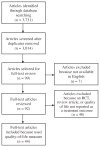Quality of life as an outcome of opioid use disorder treatment: A systematic review
- PMID: 28190543
- PMCID: PMC5402314
- DOI: 10.1016/j.jsat.2017.01.019
Quality of life as an outcome of opioid use disorder treatment: A systematic review
Abstract
Background and aims: The recent opioid epidemic has prompted renewed interest in opioid use disorder treatment, but there is little evidence regarding health-related quality-of-life (HRQoL) outcomes in treatment programs. Measuring HRQoL represents an opportunity to consider outcomes of opioid use disorder treatment that are more patient-centered and more relevant to overall health than abstinence alone. We conducted a systematic literature review to explore the extent to which the collection of HRQoL by opioid treatment programs is documented in the treatment program literature.
Materials and methods: We searched PubMed, Embase PsycINFO and Web of Science for papers published between 1965 and 2015 that reported HRQoL outcome measures from substance abuse treatment programs.
Results: Of the 3014 unduplicated articles initially identified for screening, 99 articles met criteria for further review. Of those articles, 7 were unavailable in English; therefore 92 articles were reviewed. Of these articles, 44 included any quality-of-life measure, 17 of which included validated HRQoL measures, and 10 supported derivation of quality-adjusted life year utility weights. The most frequently used validated measure was the Addiction Severity Index (ASI). Non-U.S. and more recent studies were more likely to include a measure of HRQoL.
Conclusions: HRQoL measures are rarely used as outcomes in opioid treatment programs. The field should incorporate HRQoL measures as standard practice, especially measures that can be used to derive utility weights, such as the SF-12 or EQ-5D. These instruments provide policy makers with evidence on the impact of programs on patients' lives and with data to quantify the value of investing in opioid use disorder treatments.
Keywords: Health-related quality-of-life; Opioid use disorder treatment; Systematic review.
Copyright © 2017 Elsevier Inc. All rights reserved.
References
-
- Amato L, Davoli M, Perucci CA, Ferri M, Faggiano F, Mattick RP. An overview of systematic reviews of the effectiveness of opiate maintenance therapies: Available evidence to inform clinical practice and research. Journal of Substance Abuse Treatment. 2005;28(4):321–329. http://dx.doi.org/10.1016/j.jsat.2005.02.007. - DOI - PubMed
-
- Andrews CM, D’Aunno TA, Pollack HA, Friedmann PD. Adoption of evidence-based clinical innovations: The case of buprenorphine use by opioid treatment programs. Medical Care Research and Review. 2014;71(1):43–60. http://dx.doi.org/10.1177/1077558713503188. - DOI - PMC - PubMed
-
- Astals M, Domingo-Salvany A, Buenaventura CC, Tato J, Vazquez JM, Martin-Santos R, Torrens M. Impact of substance dependence and dual diagnosis on the quality of life of heroin users seeking treatment. Substance Use & Misuse. 2008;43(5):612–632. - PubMed
-
- Blendon R, McMurtry C, Benson J, Sayde J. the opioid abuse crisis is a rare area of Bipartisan consensus. 2016 Retrieved from http://healthaffairs.org/blog/2016/09/12/the-opioid-abuse-crisis-is-a-ra...
-
- Brazier J, Roberts J, Deverill M. The estimation of a preference-based measure of health from the SF-36. Journal of Health Economics. 2002;21(2):271–292. S0167-6296(01)00130-8 [pii] - PubMed
Publication types
MeSH terms
Grants and funding
LinkOut - more resources
Full Text Sources
Other Literature Sources
Medical
Miscellaneous


